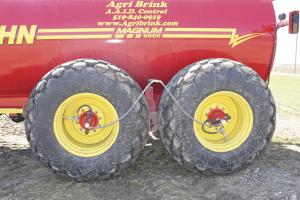2011 - Volume #35, Issue #3, Page #03
[ Sample Stories From This Issue | List of All Stories In This Issue | Print this story
| Read this issue]
Farm-Designed System Inflates/Deflates Tires On-The-Go
 |
"We need 28 psi when our tank is full and on the road, but in the field we need to be at 14 psi to minimize compaction," says Kraayenbrink. "Turning at the headlands, we like to be at 20 psi, which is easier on the tires and also doesn't pull up dirt ridges like lower pressures do."
With the help of engineers from the University of Guelph, the Ontario farmer successfully designed his Automatic Air Inflation/Deflation (AAID) system. After testing the AAID on his own manure tank, his company, AgriBrink, has just installed its first system commercially.
"It went on a new 12,000-gal. Nuhn Quad tanker," says Kraayenbrink. "Deflating its tires will double its footprint and reduce its compaction impact in the field. It'll also extend tire life."
The AAID system consists of air supply, controls and delivery components. Air supply includes tanks pressurized to 150 to 170 psi and a small compressor with a hydraulic pump. Air control includes sensors, valves, a small pressure tank and the manual override. It triggers air release and pumping. The air delivery system, with airlines, brackets and quick release valves, provides 360-degree access to the revolving tire valve stem.
The control box is designed with quick connects and pins so it can be used on more than one piece of equipment, once the air compressor and delivery systems are installed.
The small (12-in. by 8-in. by 3-in.) box contains an rpm sensor for the compressor, as well as an automatic control system with its valves and mini-pressure tank and a manual override.
"If for some reason, the automatic system with toggle control switch in the cab didn't work, the operator can go to the control box and adjust the pressure as needed," says Kraayenbrink.
When the operator hits the toggle switch in the cab, valves open, and the tire pressure drops from 28 psi to 14 psi in 25 seconds. Reserve air in the tanks reinflates on demand from 14 psi to 22 psi in two minutes time, at which point the compressor kicks in and continues inflation.
"I can safely run my empty tank at 22 psi on the road, but not at 14 psi, so full inflation isn't so critical," explains Kraayenbrink. "Once the tires are back up to 28 psi, the compressor refills the reserve tanks."
The air delivery system was one of the more challenging aspects to the project. A bracket had to be designed and installed to carry air lines to the outer face of the wheel. The 3/4-in. valve stem has its own shut-off to retain pressure should a leak develop in the lines. A swivel over the hub allows the final portion of the line to rotate with the wheel stem.
Currently, the air control system is priced at $2,500. The delivery system is around $600 per tire. The cost of the air supply with its tanks and compressor will depend on how quickly tires need to be inflated or deflated and how many tires are involved.
"The complete AAID control, supply and delivery system we just installed is for four large tires, and it cost under $12,000 for everything," says Kraayenbrink. "If there are only two tires and less volume, the cost would be considerably lower."
Contact: FARM SHOW Followup, AgriBrink, RR 1, Moorefield, Ont., Canada N0G 2K0 (ph 519 840-0919; info@agribrink.com; www.agribrink.com).

Click here to download page story appeared in.

Click here to read entire issue
To read the rest of this story, download this issue below or click here to register with your account number.




